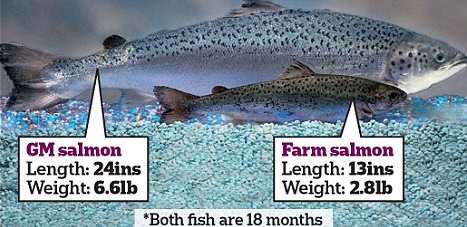Christopher
Labos is a Montreal doctor (Division of Epidemiology, Biostatistics
and Occupational Health McGill University )who writes about
medicine and health issues.
The
U.S. Food and Drug Administration has given a green light to
a genetically modified salmon, the first GMO animal ever submitted
for regulatory approval. Some think this will lead to the salvation
of humanity, and others to its downfall. I think it’s
just a fish.
What
happened is that biotech researchers mapped the genome of the
Atlantic salmon and then made two modifications. First, they
incorporated the growth hormone gene of the Chinook salmon into
the Atlantic salmon genome. Then they turned on a promoter to
keep  the
growth hormone gene turned on year round. Normally the growth
hormone gene is turned off during the winter when food is scarce.
The result is an Atlantic salmon that grows bigger and twice
as quickly, maturing in two years as opposed to four.
the
growth hormone gene turned on year round. Normally the growth
hormone gene is turned off during the winter when food is scarce.
The result is an Atlantic salmon that grows bigger and twice
as quickly, maturing in two years as opposed to four.
But
that the mere fact that this salmon was genetically modified
has raised a storm of protest. People are scared of GMOs because,
to a large extent, they don’t understand the technology,
and they They see it as something new and scary. That’s
ironic, because we’ve been genetically modifying our food
for thousands of years.
When
the Spanish first explored the Andes, the tomato was a yellow
cherry-sized fruit. Humans turned it into the big red juicy
things we see in supermarkets. Ears of corn used to be one inch
long but now they are over a foot. We have also done it to our
animals. We turned wild aurochs into placid cud chewing cows.
We turned hairy wild boars with tusks into smooth pink piggies.
We created the mule. And of course we took the wolf and turned
it into every dog on the planet from the chihuahua to the Great
Dane. This wasn’t “natural evolution.” People
purposefully created these animals. After all, did you really
think a poodle could survive in the wild?
Our
ancestors did this using a number of different means: selective
breeding/planting, cross breeding/pollination and, of course,
cloning. Seedless grapes, potatoes, and bananas are all clones,
meaning that they are grown by transplanting a branch of the
original plant into a new milieu. Incidentally, the word cloning
comes from the ancient Greek word for branch and the process
has been in use since before people knew about genetics or genes.
This
ancient biotechnology is actually far more dangerous than what
is practiced in a lab today. When you cross-breed two species
of plants, you swap tens of thousands of genes randomly, with
no real way of knowing what the final result will look like.
With current biotechnology, you can change one gene at a time
in a controlled fashion and study the results. People become
scared when you talk about swapping genes, but this occurs all
the time in nature. Genes flow between crops all the time when
pollen is blown across fields by the wind or carried over by
bees.
In
the 1980s, scientists took the human gene for insulin and put
it into a bacterium. The bacteria did not become highly intelligent.
There was no global pandemic, nor a zombie apocalypse. The only
thing that happened is that we created a new, cheap and safer
way to get insulin that did not require slaughtering legions
of cows and pigs for their pancreas. Now we can incorporate
DNA into tiny viruses and use them to deliver DNA directly into
cells. With that technology we might be able to cure cystic
fibrosis, hemophilia and even fight cancer. It’s not quite
ready for prime time yet, but pretty soon hopefully.
So
if you’re scared about this new genetically modified fish,
don’t be. This fish has been under FDA review for 20 years
with no suggestion of harm. More broadly, GMOs do not cause
cancer or any other disease. We have been genetically modifying
our food since the dawn of civilization and nothing bad has
happened.